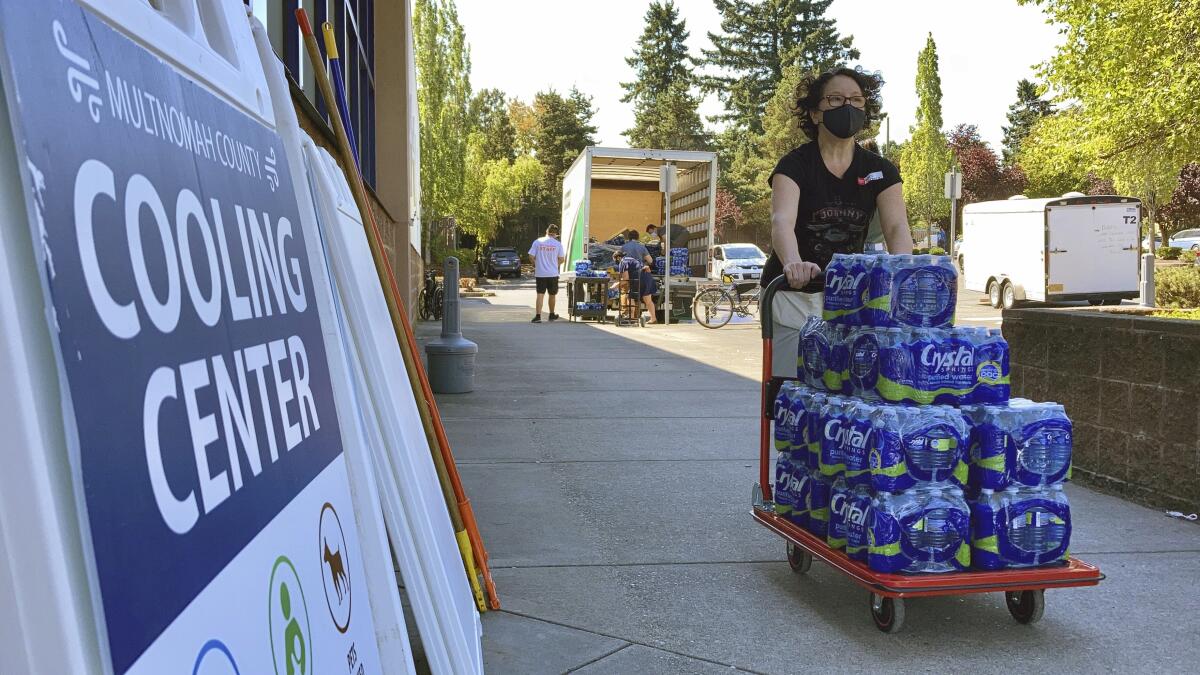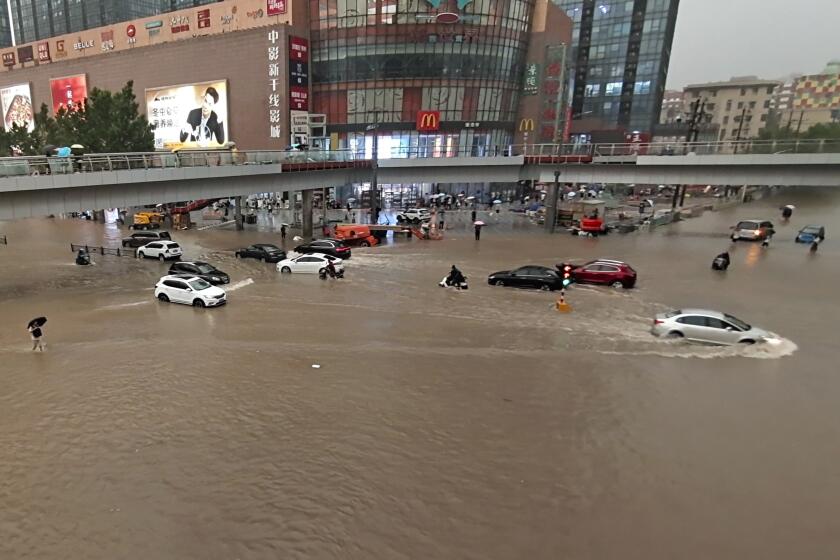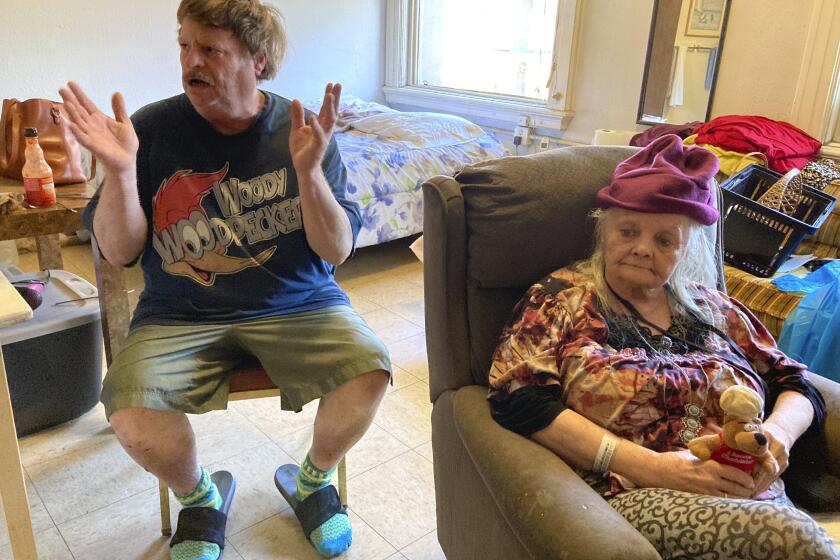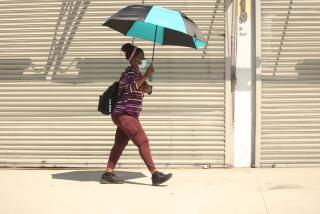Heat wave hits Northwest, sending people to cooling centers

PORTLAND, Ore. â People headed to cooling centers Wednesday as the Pacific Northwest began sweltering under another major, multiday heat wave just over a month after record-shattering hot weather killed hundreds of the regionâs most vulnerable people.
Temperatures soared to 95 degrees by midafternoon in Portland. In a âworst-case scenario,â the temperature could reach as high as 111 in some parts of western Oregon this week before a weekend cool-down, the National Weather Service said. Itâs more likely temperatures will rise to 100 or above for three consecutive days, peaking around 105 on Thursday.
Sizzling weather also was expected in other parts of the country. The weather service said heat advisories and warnings would be in effect from the Midwest to the Northeast and mid-Atlantic through at least Friday.
The high temperatures in Portland, part of a usually temperate region, would break records this week if the late June heat wave had not done so already, meteorologist Tyler Kranz said. Seattle will be cooler than Portland, with temperatures in the mid-90s, but it still has a chance to break records, and many people there, as in Oregon, donât have air conditioning.
The forecast was hotter than for Phoenix, a desert city notorious for its blistering summertime temperatures.
âWeâll often hear people say, âWho cares if itâs 106 or 108? It gets this hot in Arizona all the time.â Well, people in Arizona have air conditioning, and here in the Pacific Northwest, a lot of people donât,â Kranz said. âYou canât really compare us to the desert Southwest.â
People began coming into a 24-hour cooling center in North Portland before it opened Wednesday. Volunteers and county employees set up cots and stacked hundreds of bottles of water in the air-conditioned center in a vacant building.
The first few people in were experiencing homelessness, a population vulnerable to extreme heat. Among them was December Snedecor, who slept two nights in the same center in June when temperatures reached 116.
She said she planned to sleep there again this week because the heat in her tent was unbearable.
âI poured water over myself a lot. It was up in the teens, hundred-and-something heat. It made me dizzy. It was not good,â Snedecor said of the June heat. âIâve just got to stay cool. I donât want to die.â
Gov. Kate Brown has declared a state of emergency over the heat and activated an emergency operations center, citing the potential for disruptions to the power grid and transportation. Besides opening cooling centers, city and county governments are extending public library hours and waiving bus fare for those headed to cooling centers. A 24-hour statewide help line will direct callers to the nearest cooling shelter and offer safety tips.
Emergency officials have sent alerts to phones, said Dan Douthit, spokesman for the Portland Bureau of Emergency Management.
âWe donât know exactly how hot it will get,â he said, âbut weâre planning for a worst-case scenario.â
Climate change is making the world more prone to floods like those in China and Europe and to heat waves and fires like those in the U.S. and Russia.
The back-to-back heat waves, coupled with a summer thatâs been exceptionally warm and dry overall, are pummeling a region where summer highs usually drift into the 70s or 80s. Both the heat and a historic drought across the American West reflect climate change that makes weather more extreme in the historically temperate region.
The June heat in Oregon, Washington and Canadaâs British Columbia contributed to the deaths of hundreds of people and was a wake-up call for whatâs ahead in a warming world. It was virtually impossible without human-caused climate change, a scientific analysis found.
In Oregon, officials have released the names of 96 people who died of heat-related illness, and the hot weather was being investigated as a possible cause in many more deaths. Washington state reported more than 100 heat deaths, and officials in British Columbia said hundreds of âsudden and unexpected deathsâ were likely due to the soaring temperatures.
The toll exposed huge blind spots in emergency planning in a region unaccustomed to dealing with such high temperatures, said Vivek Shandas, a professor of climate adaptation at Portland State University.
Most of those who died in Oregon were older, homebound and socially isolated, and many were unable, or unwilling, to get to cooling centers.
This summerâs Pacific Northwest heat wave killed scores of the regionâs most vulnerable who couldnât leave their homes or afford air conditioning.
The call center designed to provide information about cooling centers was unstaffed during part of the peak heat, and hundreds of callers got stuck in a voicemail menu that didnât include a prompt for heat-related help. Portlandâs famed light-rail train also shut down to reduce strain on the power grid, eliminating a transportation option for low-income residents seeking relief.
This time, local and state officials have added more cooling centers and included a prompt in the call center voicemail.
âWe knew a week in advance. What would happen if we knew an earthquake was going to hit us a week in advance?â Shandas said. âThatâs the kind of thinking we need to be aligned with.â
Even younger residents struggled with the heat in June and were dreading this weekâs sweltering temperatures.
Katherine Morgan, 27, has no air-conditioning in her third-floor apartment and canât afford a window unit on the money she makes working at a bookstore and as a hostess at a brewery.
Sheâll have to walk to work Thursday, the day when temperatures could again soar.
âAll my friends and I knew that climate change was real,â Morgan said, âbut itâs getting really scary because it was gradually getting hot â and it suddenly got really hot, really fast.â
More to Read
Sign up for Essential California
The most important California stories and recommendations in your inbox every morning.
You may occasionally receive promotional content from the Los Angeles Times.












